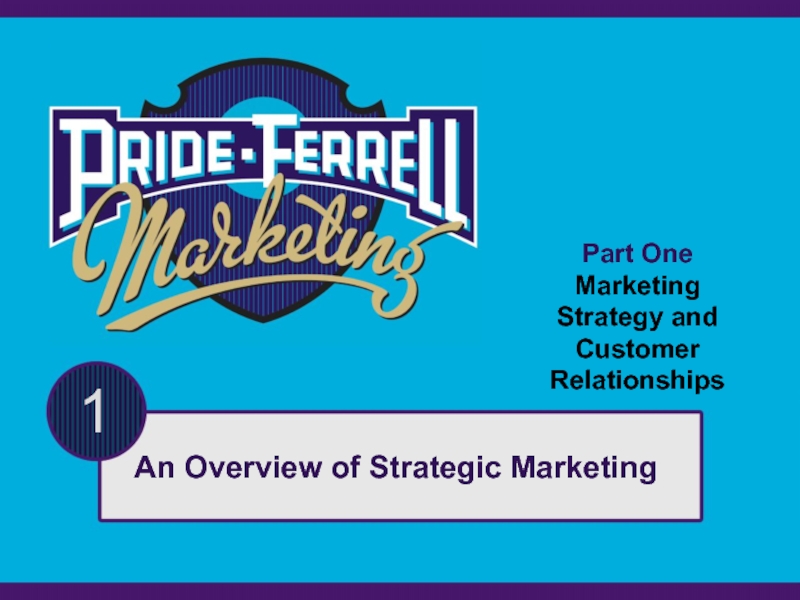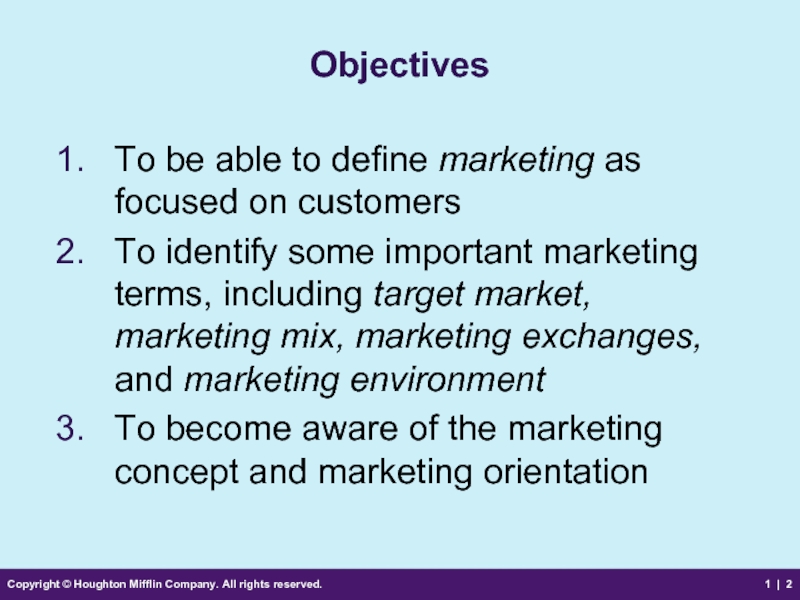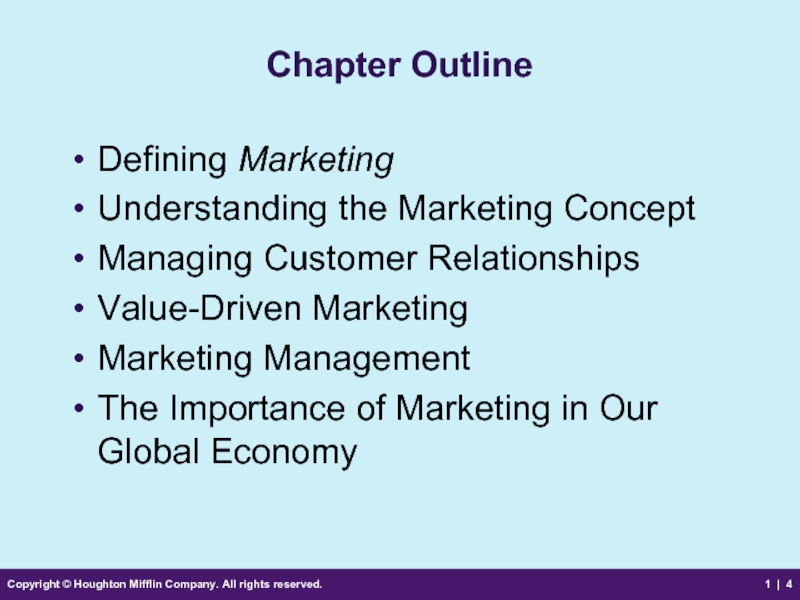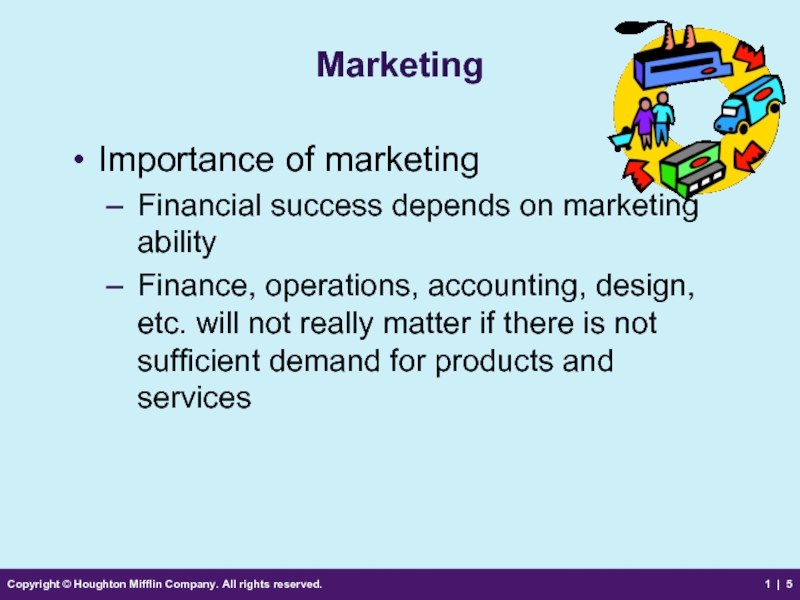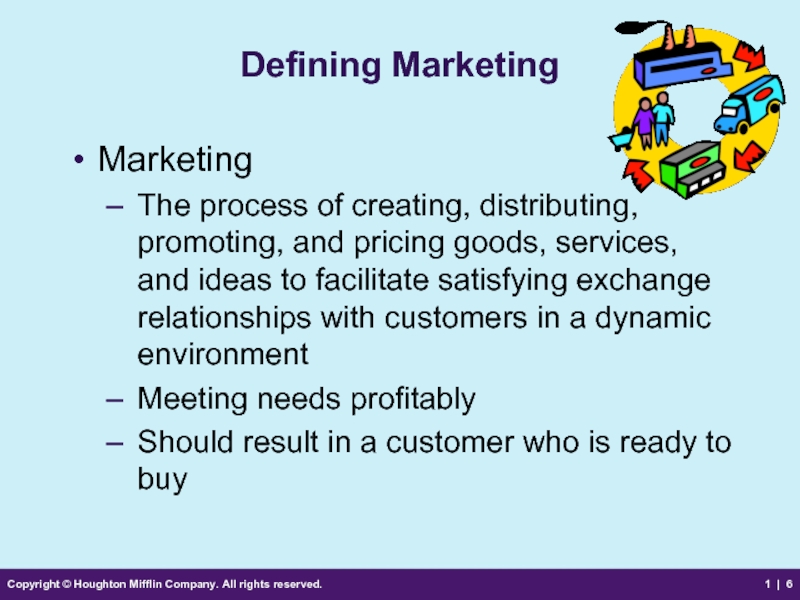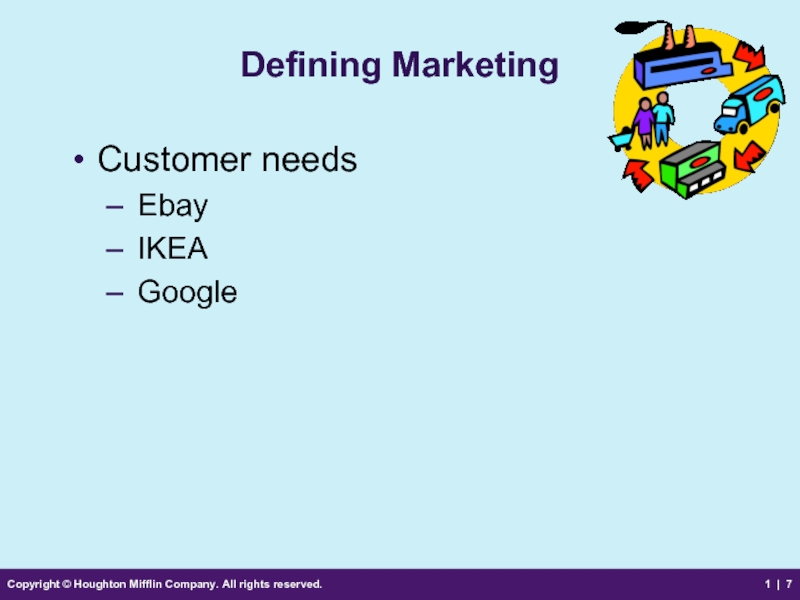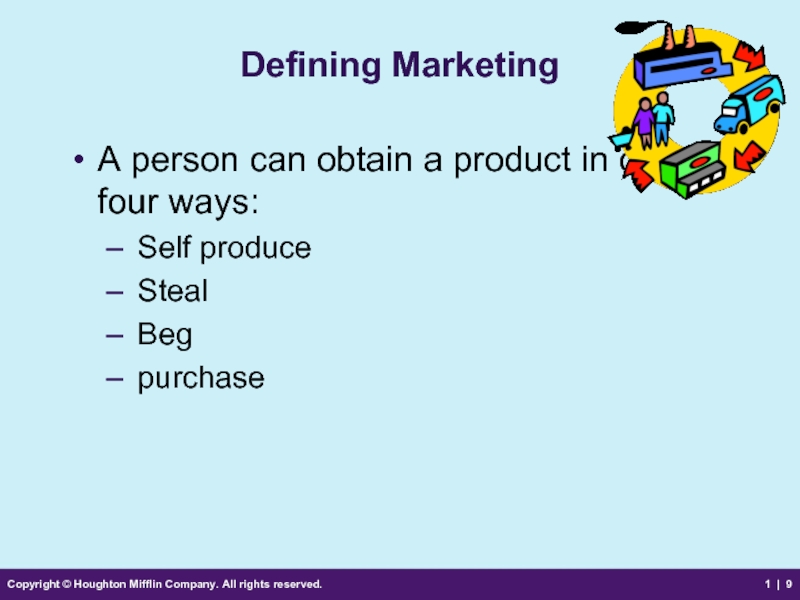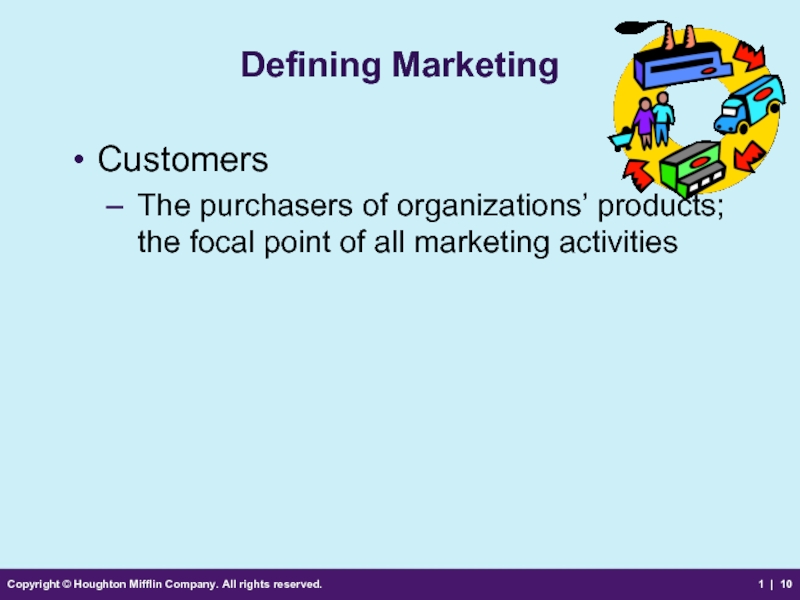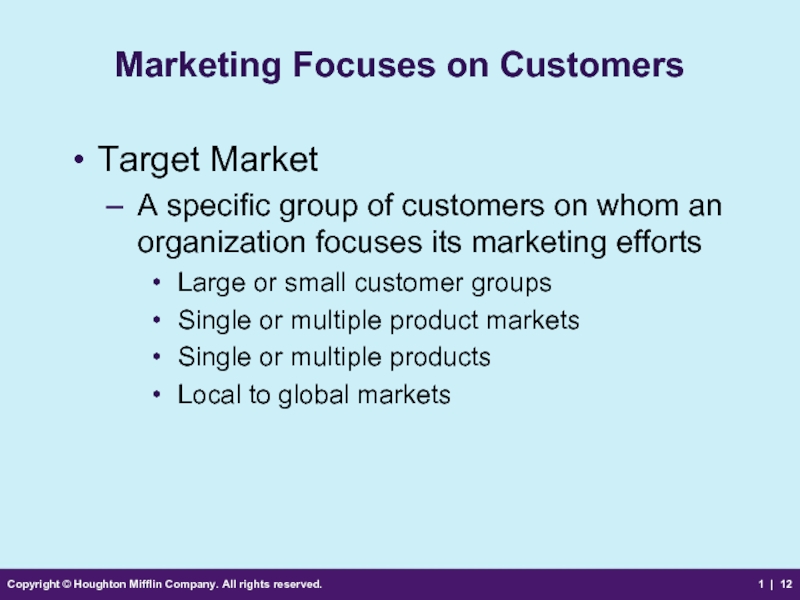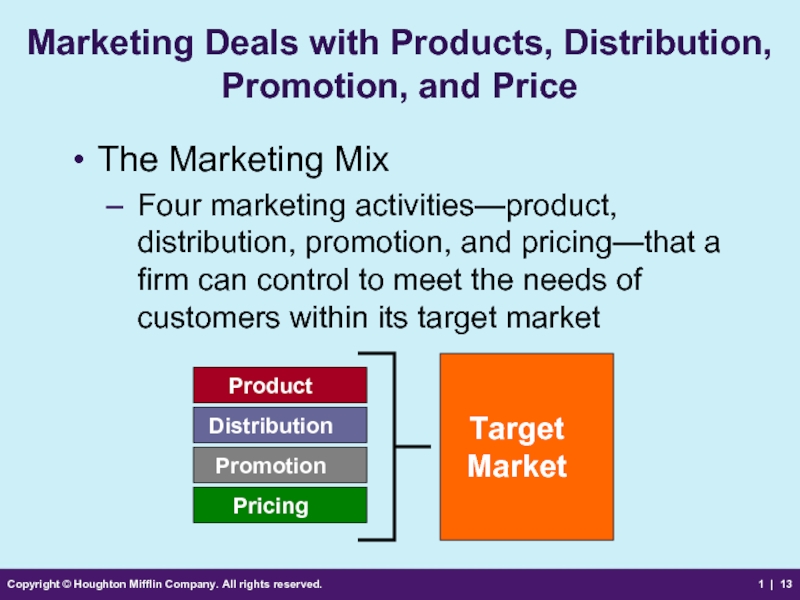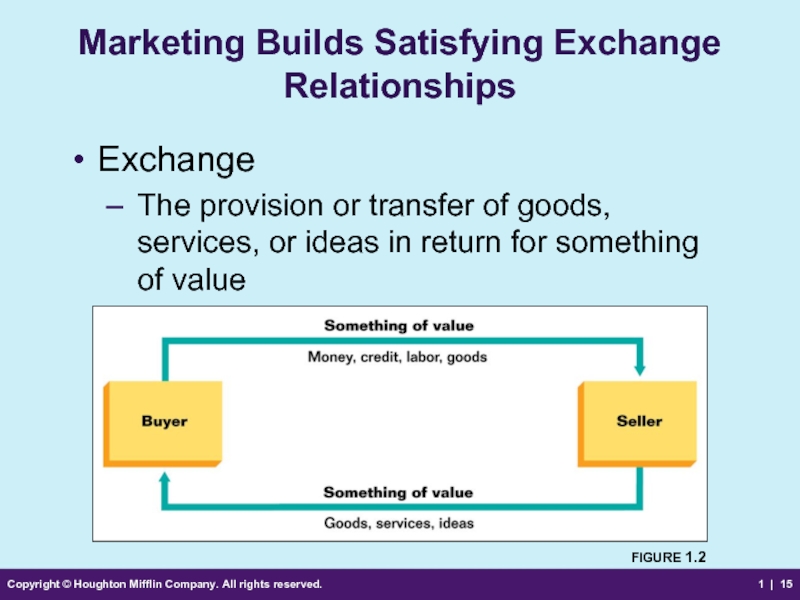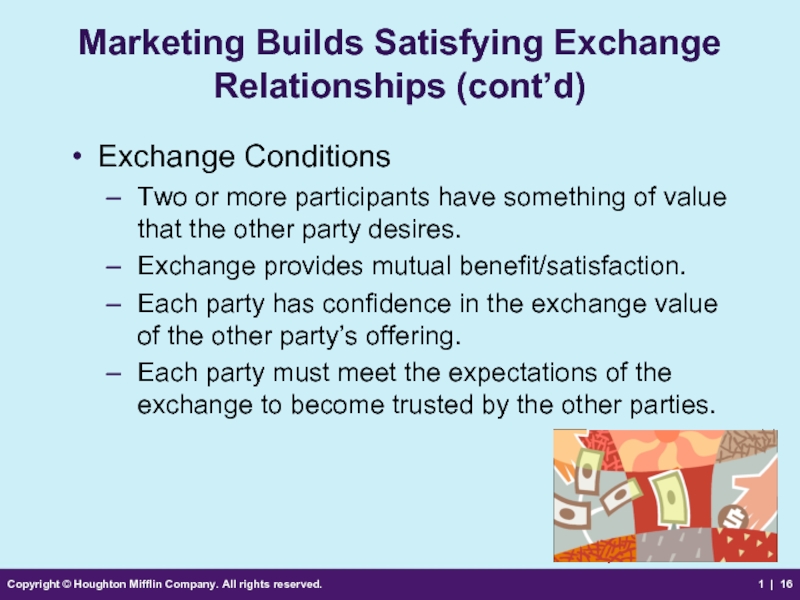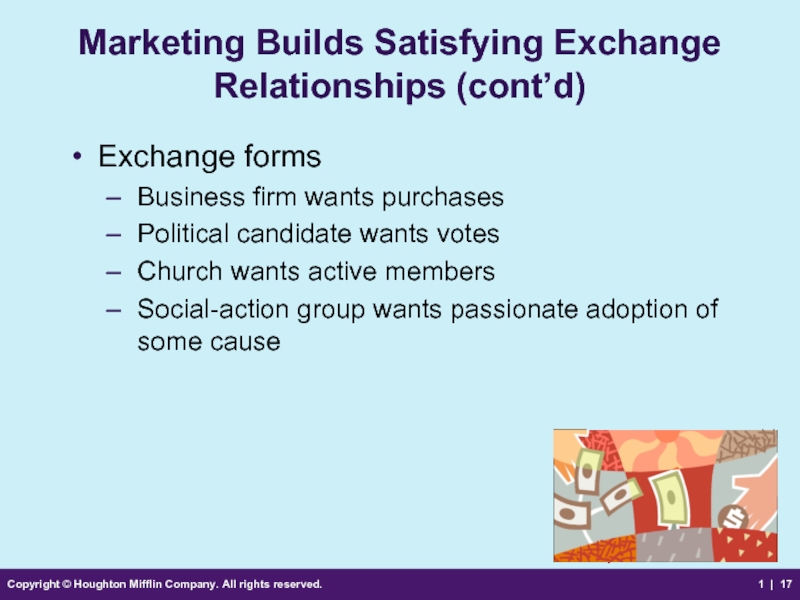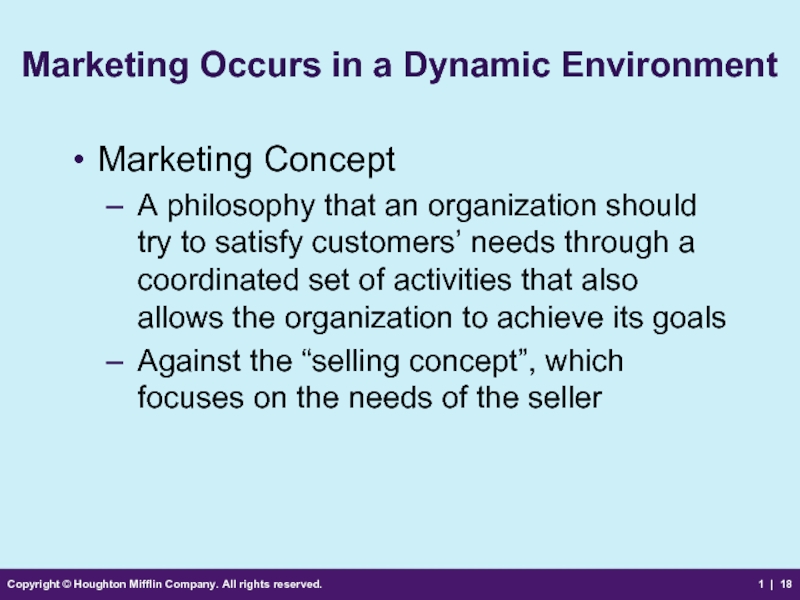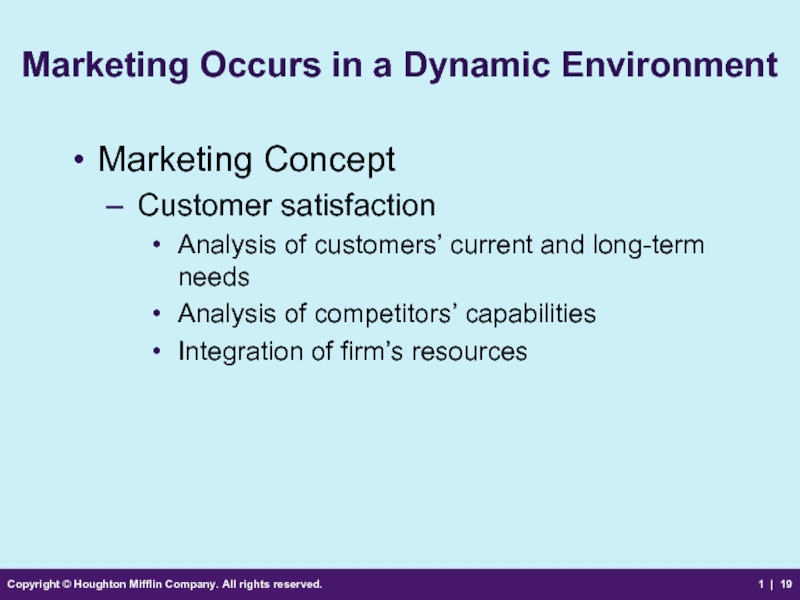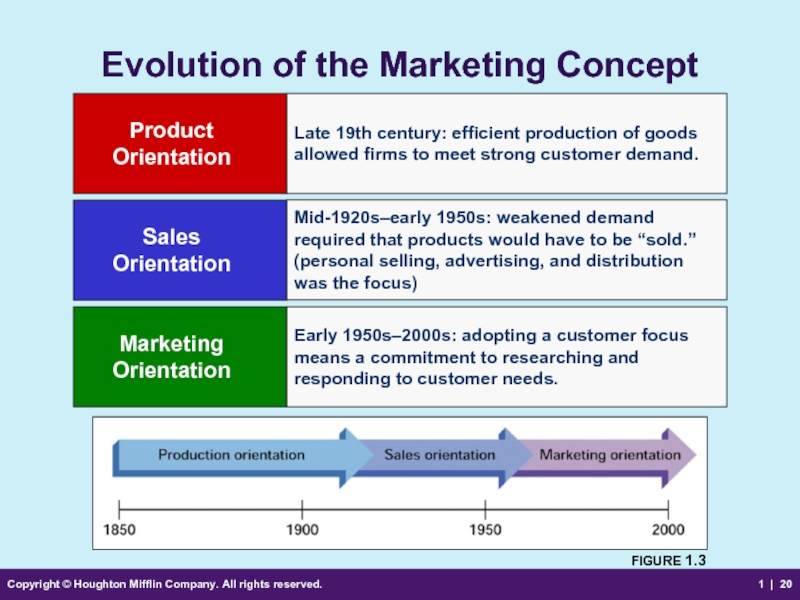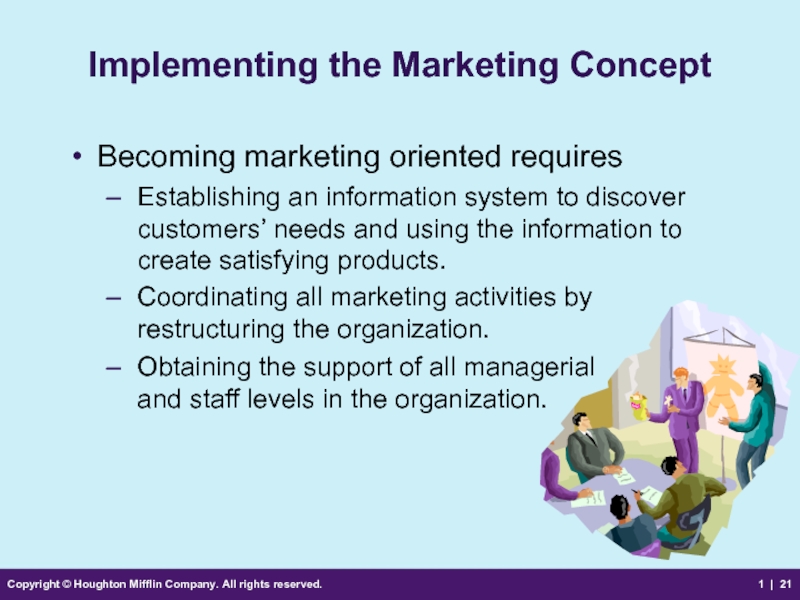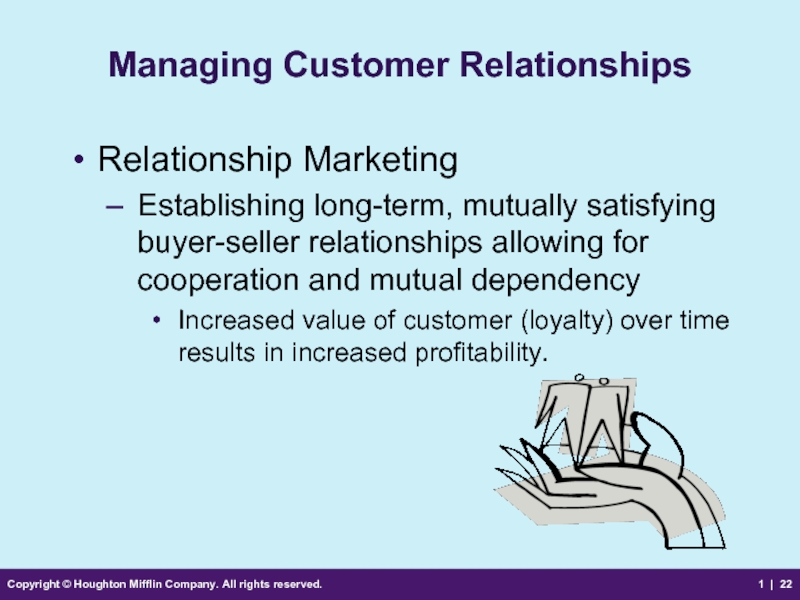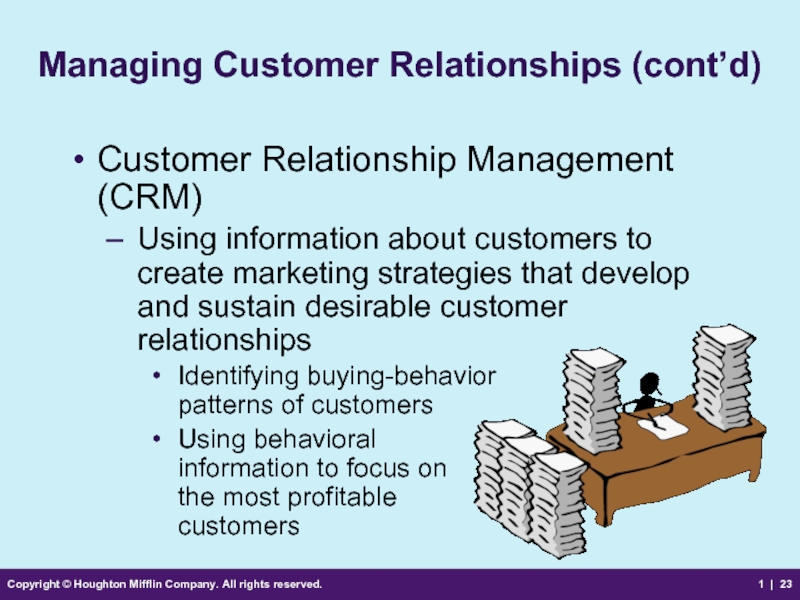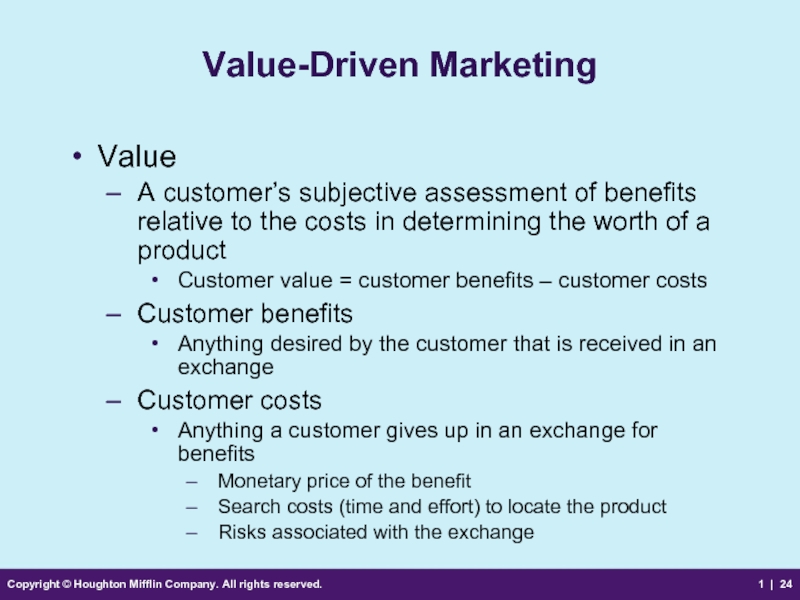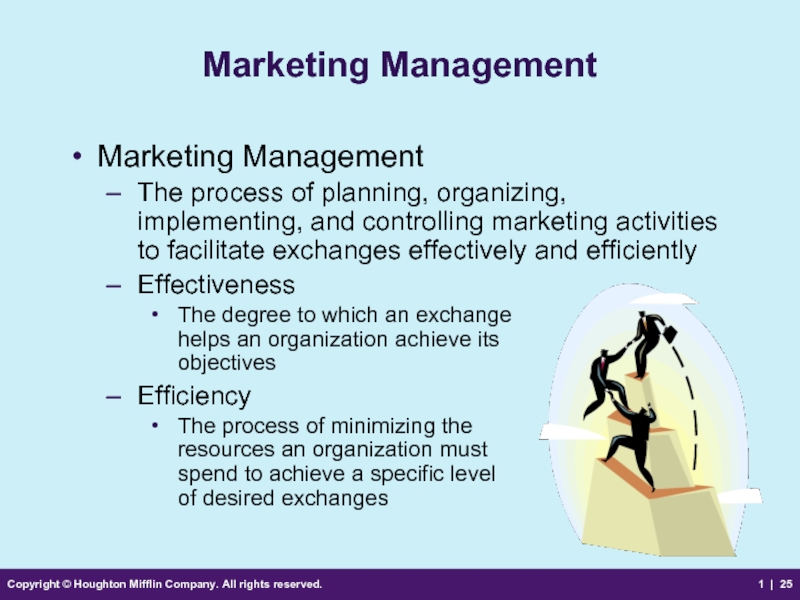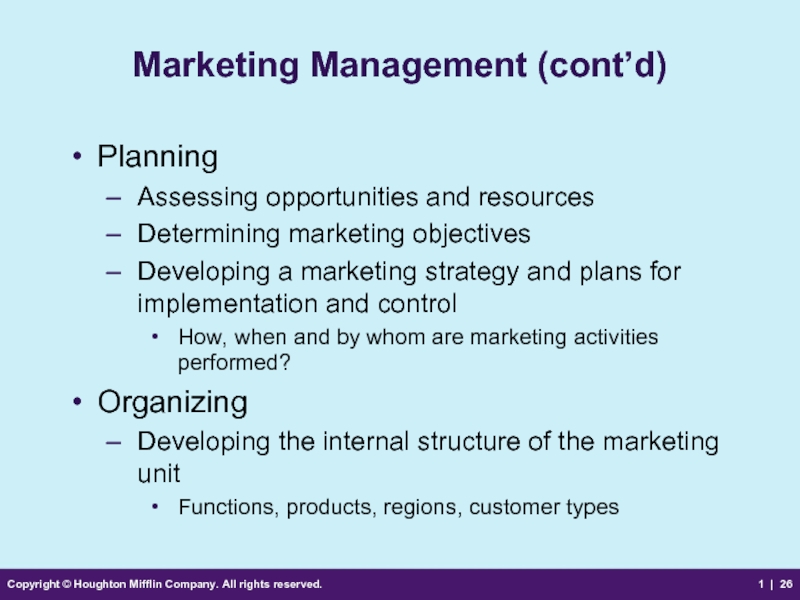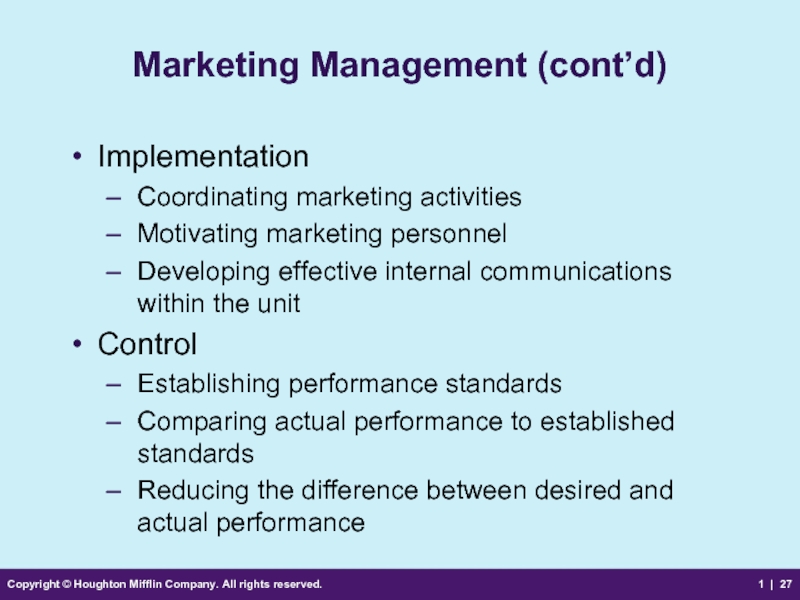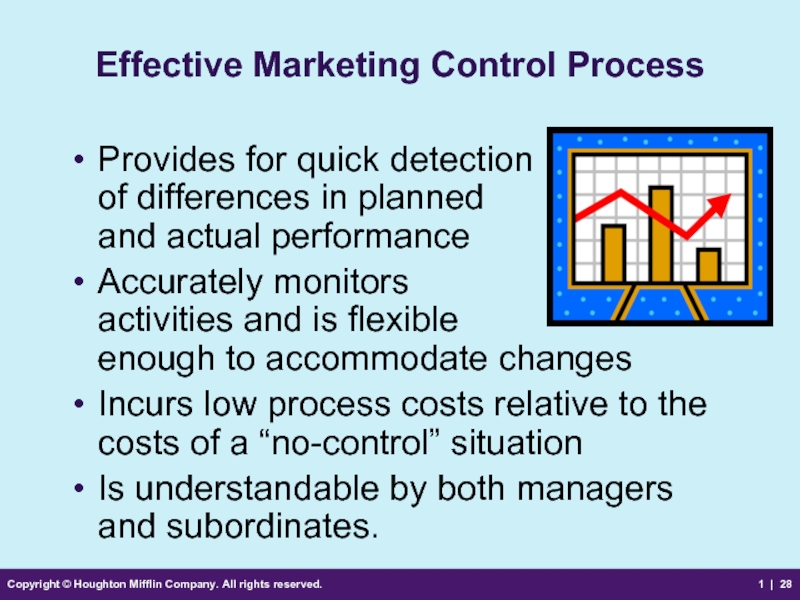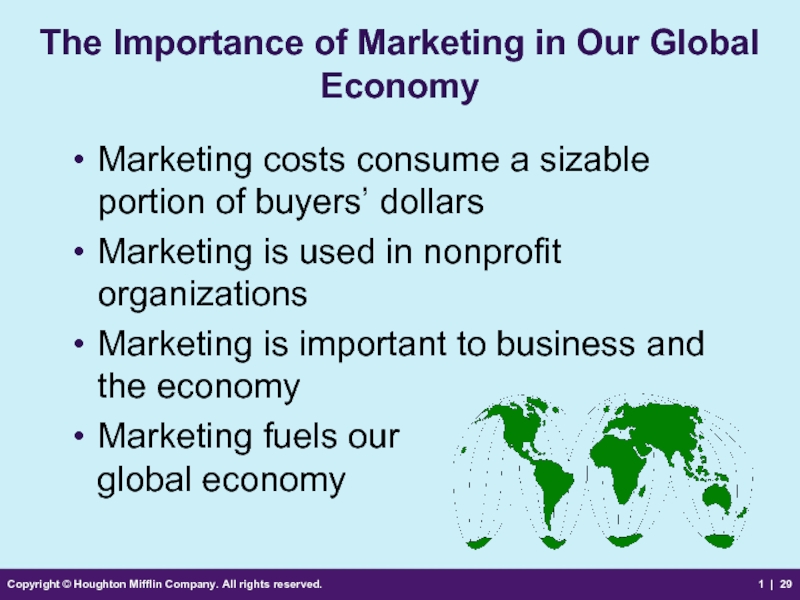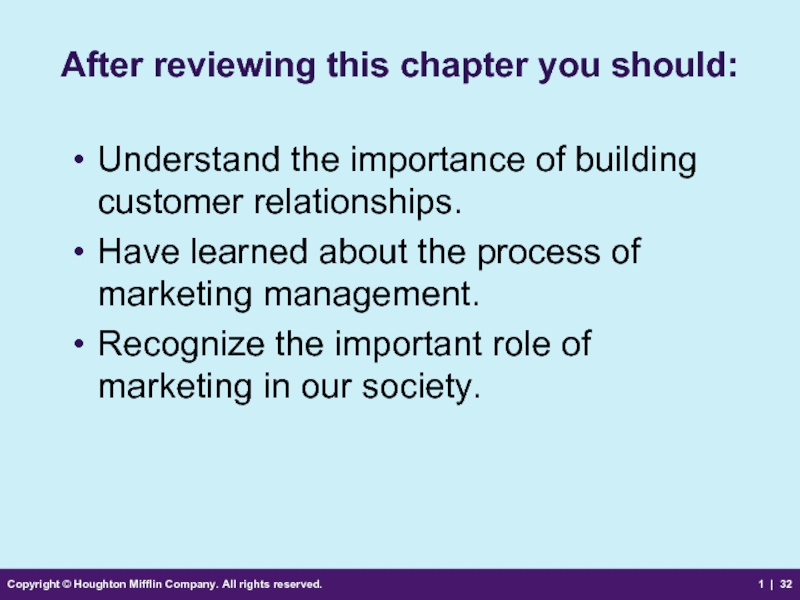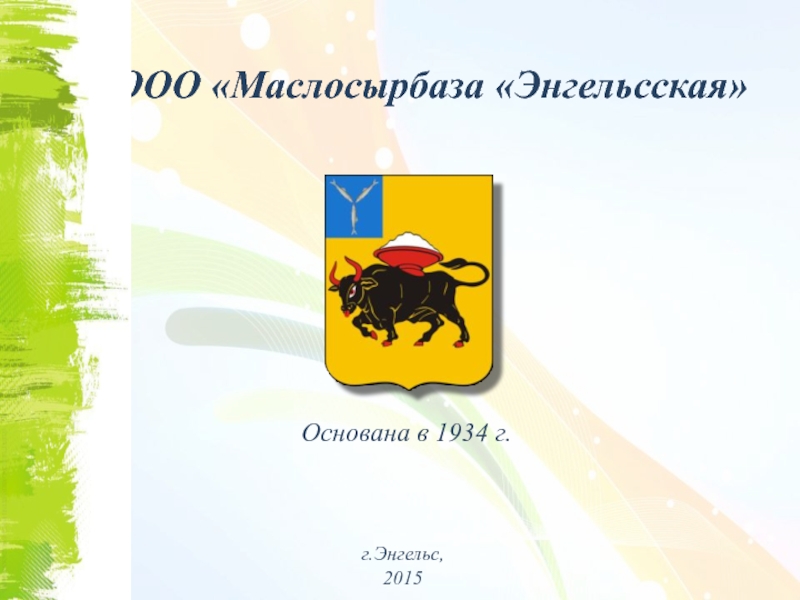- Главная
- Разное
- Дизайн
- Бизнес и предпринимательство
- Аналитика
- Образование
- Развлечения
- Красота и здоровье
- Финансы
- Государство
- Путешествия
- Спорт
- Недвижимость
- Армия
- Графика
- Культурология
- Еда и кулинария
- Лингвистика
- Английский язык
- Астрономия
- Алгебра
- Биология
- География
- Детские презентации
- Информатика
- История
- Литература
- Маркетинг
- Математика
- Медицина
- Менеджмент
- Музыка
- МХК
- Немецкий язык
- ОБЖ
- Обществознание
- Окружающий мир
- Педагогика
- Русский язык
- Технология
- Физика
- Философия
- Химия
- Шаблоны, картинки для презентаций
- Экология
- Экономика
- Юриспруденция
Marketing strategy and customer relationships. An overview of strategic marketing презентация
Содержание
- 1. Marketing strategy and customer relationships. An overview of strategic marketing
- 2. Copyright © Houghton Mifflin Company. All rights
- 3. Copyright © Houghton Mifflin Company. All rights
- 4. Copyright © Houghton Mifflin Company. All rights
- 5. Copyright © Houghton Mifflin Company. All rights
- 6. Copyright © Houghton Mifflin Company. All rights
- 7. Copyright © Houghton Mifflin Company. All rights
- 8. Copyright © Houghton Mifflin Company. All rights
- 9. Copyright © Houghton Mifflin Company. All rights
- 10. Copyright © Houghton Mifflin Company. All rights
- 11. Copyright © Houghton Mifflin Company. All rights
- 12. Copyright © Houghton Mifflin Company. All rights
- 13. Copyright © Houghton Mifflin Company. All rights
- 14. Copyright © Houghton Mifflin Company. All rights
- 15. Copyright © Houghton Mifflin Company. All rights
- 16. Copyright © Houghton Mifflin Company. All rights
- 17. Copyright © Houghton Mifflin Company. All rights
- 18. Copyright © Houghton Mifflin Company. All rights
- 19. Copyright © Houghton Mifflin Company. All rights
- 20. Copyright © Houghton Mifflin Company. All rights
- 21. Copyright © Houghton Mifflin Company. All rights
- 22. Copyright © Houghton Mifflin Company. All rights
- 23. Copyright © Houghton Mifflin Company. All rights
- 24. Copyright © Houghton Mifflin Company. All rights
- 25. Copyright © Houghton Mifflin Company. All rights
- 26. Copyright © Houghton Mifflin Company. All rights
- 27. Copyright © Houghton Mifflin Company. All rights
- 28. Copyright © Houghton Mifflin Company. All rights
- 29. Copyright © Houghton Mifflin Company. All rights
- 30. Copyright © Houghton Mifflin Company. All rights
- 31. Copyright © Houghton Mifflin Company. All rights
- 32. Copyright © Houghton Mifflin Company. All rights
Слайд 2Copyright © Houghton Mifflin Company. All rights reserved.
1 |
Objectives
To be
To identify some important marketing terms, including target market, marketing mix, marketing exchanges, and marketing environment
To become aware of the marketing concept and marketing orientation
Слайд 3Copyright © Houghton Mifflin Company. All rights reserved.
1 |
Objectives (cont’d)
To
To learn about the process of marketing management
To recognize the role of marketing in our society
Слайд 4Copyright © Houghton Mifflin Company. All rights reserved.
1 |
Chapter Outline
Defining
Understanding the Marketing Concept
Managing Customer Relationships
Value-Driven Marketing
Marketing Management
The Importance of Marketing in Our Global Economy
Слайд 5Copyright © Houghton Mifflin Company. All rights reserved.
1 |
Marketing
Importance of
Financial success depends on marketing ability
Finance, operations, accounting, design, etc. will not really matter if there is not sufficient demand for products and services
Слайд 6Copyright © Houghton Mifflin Company. All rights reserved.
1 |
Defining Marketing
Marketing
The
Meeting needs profitably
Should result in a customer who is ready to buy
Слайд 7Copyright © Houghton Mifflin Company. All rights reserved.
1 |
Defining Marketing
Customer
Ebay
IKEA
Слайд 8Copyright © Houghton Mifflin Company. All rights reserved.
1 |
Defining Marketing
Marketing
What features to design into a product
What prices to offer customers
Where to sell products
How much to spend on advertising
Wording on packaging
Design of packaging
Слайд 9Copyright © Houghton Mifflin Company. All rights reserved.
1 |
Defining Marketing
A
Self produce
Steal
Beg
purchase
Слайд 10Copyright © Houghton Mifflin Company. All rights reserved.
1 |
Defining Marketing
Customers
The
Слайд 11Copyright © Houghton Mifflin Company. All rights reserved.
1 |
Components of
FIGURE 1.1
Слайд 12Copyright © Houghton Mifflin Company. All rights reserved.
1 |
Marketing Focuses
Target Market
A specific group of customers on whom an organization focuses its marketing efforts
Large or small customer groups
Single or multiple product markets
Single or multiple products
Local to global markets
Слайд 13Copyright © Houghton Mifflin Company. All rights reserved.
1 |
Marketing Deals
The Marketing Mix
Four marketing activities—product, distribution, promotion, and pricing—that a firm can control to meet the needs of customers within its target market
Слайд 14Copyright © Houghton Mifflin Company. All rights reserved.
1 |
Marketing Mix
Product
Distribution
Promotion
Pricing
Goods, services, or ideas that satisfy customer needs
The ready, convenient, and timely availability of products
Activities that inform customers about the organization and its products
Decisions and actions that establish pricing objectives and policies and set product prices
Слайд 15Copyright © Houghton Mifflin Company. All rights reserved.
1 |
Marketing Builds
Exchange
The provision or transfer of goods, services, or ideas in return for something of value
Слайд 16Copyright © Houghton Mifflin Company. All rights reserved.
1 |
Marketing Builds
Exchange Conditions
Two or more participants have something of value that the other party desires.
Exchange provides mutual benefit/satisfaction.
Each party has confidence in the exchange value of the other party’s offering.
Each party must meet the expectations of the exchange to become trusted by the other parties.
Слайд 17Copyright © Houghton Mifflin Company. All rights reserved.
1 |
Marketing Builds
Exchange forms
Business firm wants purchases
Political candidate wants votes
Church wants active members
Social-action group wants passionate adoption of some cause
Слайд 18Copyright © Houghton Mifflin Company. All rights reserved.
1 |
Marketing Occurs
Marketing Concept
A philosophy that an organization should try to satisfy customers’ needs through a coordinated set of activities that also allows the organization to achieve its goals
Against the “selling concept”, which focuses on the needs of the seller
Слайд 19Copyright © Houghton Mifflin Company. All rights reserved.
1 |
Marketing Occurs
Marketing Concept
Customer satisfaction
Analysis of customers’ current and long-term needs
Analysis of competitors’ capabilities
Integration of firm’s resources
Слайд 20Copyright © Houghton Mifflin Company. All rights reserved.
1 |
Evolution of
Product
Orientation
Sales
Orientation
Marketing
Orientation
Late 19th century: efficient production of goods allowed firms to meet strong customer demand.
Mid-1920s–early 1950s: weakened demand required that products would have to be “sold.” (personal selling, advertising, and distribution was the focus)
Early 1950s–2000s: adopting a customer focus means a commitment to researching and responding to customer needs.
Слайд 21Copyright © Houghton Mifflin Company. All rights reserved.
1 |
Implementing the
Becoming marketing oriented requires
Establishing an information system to discover customers’ needs and using the information to create satisfying products.
Coordinating all marketing activities by restructuring the organization.
Obtaining the support of all managerial
and staff levels in the organization.
Слайд 22Copyright © Houghton Mifflin Company. All rights reserved.
1 |
Managing Customer
Relationship Marketing
Establishing long-term, mutually satisfying buyer-seller relationships allowing for cooperation and mutual dependency
Increased value of customer (loyalty) over time results in increased profitability.
Слайд 23Copyright © Houghton Mifflin Company. All rights reserved.
1 |
Managing Customer
Customer Relationship Management (CRM)
Using information about customers to create marketing strategies that develop and sustain desirable customer relationships
Identifying buying-behavior
patterns of customers
Using behavioral
information to focus on
the most profitable
customers
Слайд 24Copyright © Houghton Mifflin Company. All rights reserved.
1 |
Value-Driven Marketing
Value
A
Customer value = customer benefits – customer costs
Customer benefits
Anything desired by the customer that is received in an exchange
Customer costs
Anything a customer gives up in an exchange for benefits
Monetary price of the benefit
Search costs (time and effort) to locate the product
Risks associated with the exchange
Слайд 25Copyright © Houghton Mifflin Company. All rights reserved.
1 |
Marketing Management
Marketing
The process of planning, organizing, implementing, and controlling marketing activities to facilitate exchanges effectively and efficiently
Effectiveness
The degree to which an exchange helps an organization achieve its objectives
Efficiency
The process of minimizing the resources an organization must spend to achieve a specific level of desired exchanges
Слайд 26Copyright © Houghton Mifflin Company. All rights reserved.
1 |
Marketing Management
Planning
Assessing opportunities and resources
Determining marketing objectives
Developing a marketing strategy and plans for implementation and control
How, when and by whom are marketing activities performed?
Organizing
Developing the internal structure of the marketing unit
Functions, products, regions, customer types
Слайд 27Copyright © Houghton Mifflin Company. All rights reserved.
1 |
Marketing Management
Implementation
Coordinating marketing activities
Motivating marketing personnel
Developing effective internal communications within the unit
Control
Establishing performance standards
Comparing actual performance to established standards
Reducing the difference between desired and actual performance
Слайд 28Copyright © Houghton Mifflin Company. All rights reserved.
1 |
Effective Marketing
Provides for quick detection
of differences in planned
and actual performance
Accurately monitors
activities and is flexible
enough to accommodate changes
Incurs low process costs relative to the costs of a “no-control” situation
Is understandable by both managers and subordinates.
Слайд 29Copyright © Houghton Mifflin Company. All rights reserved.
1 |
The Importance
Marketing costs consume a sizable portion of buyers’ dollars
Marketing is used in nonprofit organizations
Marketing is important to business and the economy
Marketing fuels our
global economy
Слайд 30Copyright © Houghton Mifflin Company. All rights reserved.
1 |
The Importance
Marketing knowledge enhances consumer awareness
Marketing connects people through technology
Socially responsible marketing can promote the welfare of customers and society
Marketing offers many exciting career prospects
Слайд 31Copyright © Houghton Mifflin Company. All rights reserved.
1 |
After reviewing
Be able to define marketing as focused on customers.
Know the meaning of important marketing terms, including target market, marketing mix, marketing exchanges, and marketing environment.
Be more aware of the marketing concept and marketing orientation.
Слайд 32Copyright © Houghton Mifflin Company. All rights reserved.
1 |
After reviewing
Understand the importance of building customer relationships.
Have learned about the process of marketing management.
Recognize the important role of marketing in our society.
